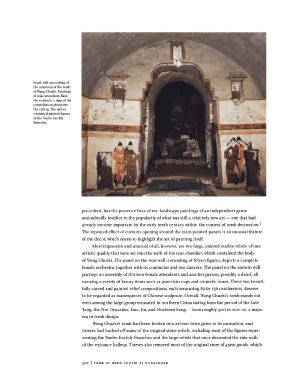Page 508 - The Golden Age of Chinese Archaeology: Celebrated Discoveries from the People’s Republic of China
P. 508
South wall and ceiling of
the anteroom of the tomb
of Wang Chuzhi. Paintings
of male attendants flank
the entrance; a map of the
constellations decorates
the ceiling. The niches
contained painted figures
of the Twelve Earthly
Branches.
precedent, but the presence here of two landscape paintings of an independent genre
undoubtedly testifies to the popularity of what was still a relatively new art — one that had
already become important by the early tenth century within the context of tomb decoration. 5
The repeated effect of curtains opening around the main painted panels is an unusual feature
of the decor, which seems to highlight the art of painting itself.
Most impressive and unusual of all, however, are two large, painted marble reliefs of rare
artistic quality that were set into the walls of the rear chamber, which contained the body
of Wang Chuzhi. The panel on the west wall, consisting of fifteen figures, depicts a complete
female orchestra, together with its conductor and two dancers. The panel on the eastern wall
portrays an assembly of thirteen female attendants and another person, possibly a dwarf, all
carrying a variety of luxury items such as porcelain cups and cosmetic boxes. These two beauti-
fully carved and painted relief compositions, each measuring 82 by 136 centimeters, deserve
to be regarded as masterpieces of Chinese sculpture. Overall, Wang Chuzhi's tomb stands out
even among the large group excavated in northern China dating from the period of the Late
Tang, the Five Dynasties, Liao, Jin, and Northern Song — from roughly 900 to 1100 CE, a major
era in tomb design.
Wang Chuzhi's tomb had been broken into at least twice prior to its excavation, and
thieves had hacked off many of the original stone reliefs, including most of the figures repre-
senting the Twelve Earthly Branches and the large reliefs that once decorated the side walls
of the entrance hallway. Thieves also removed most of the original store of grave goods, which
507 | TOMB OF WANG C H U Z H I AT X I Y A N C H U A N

